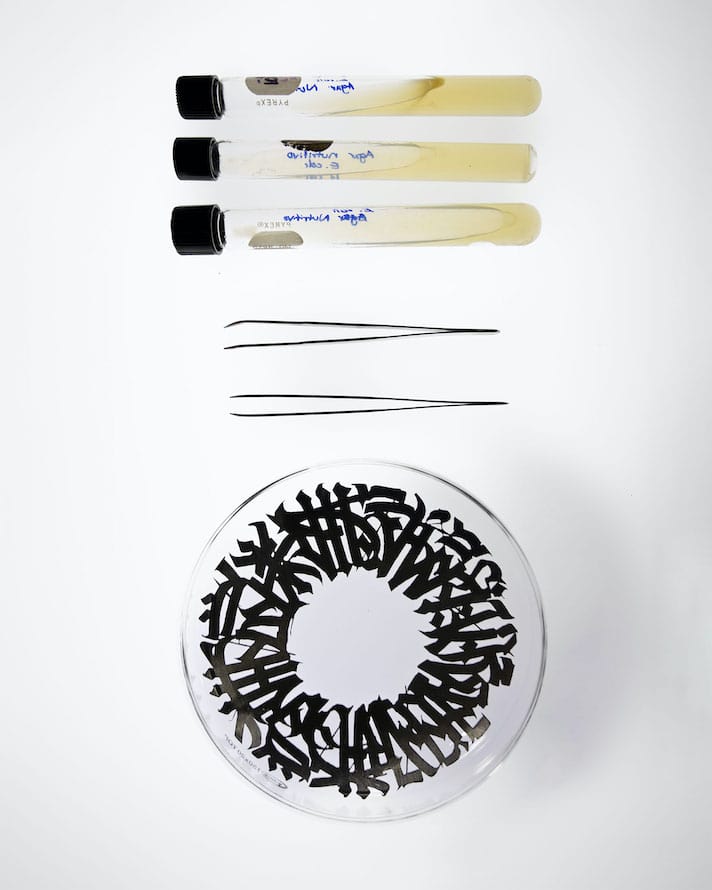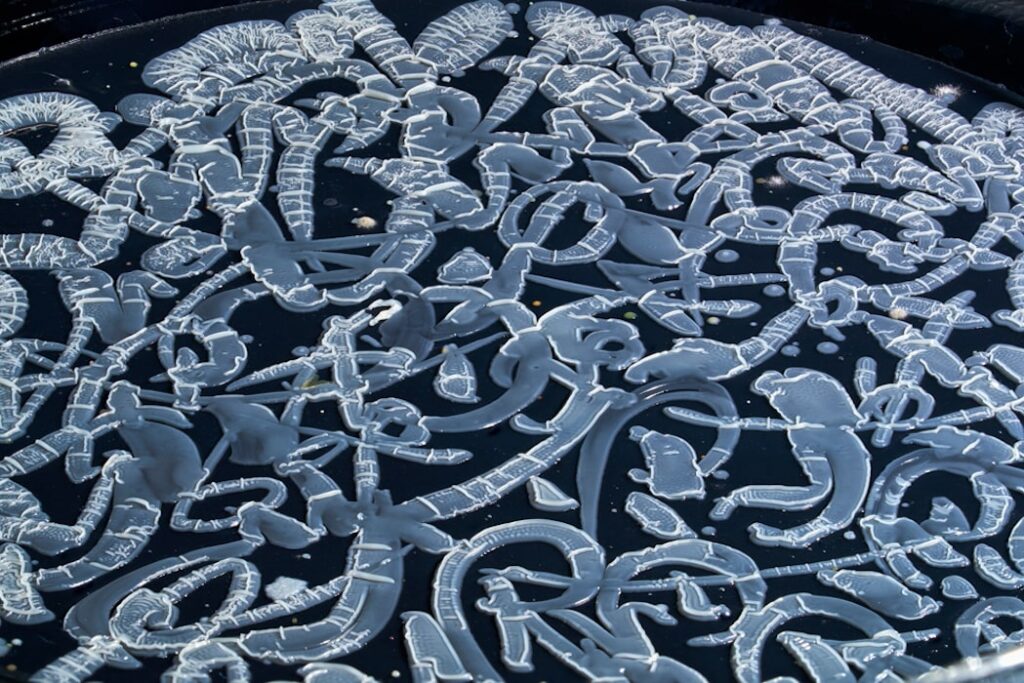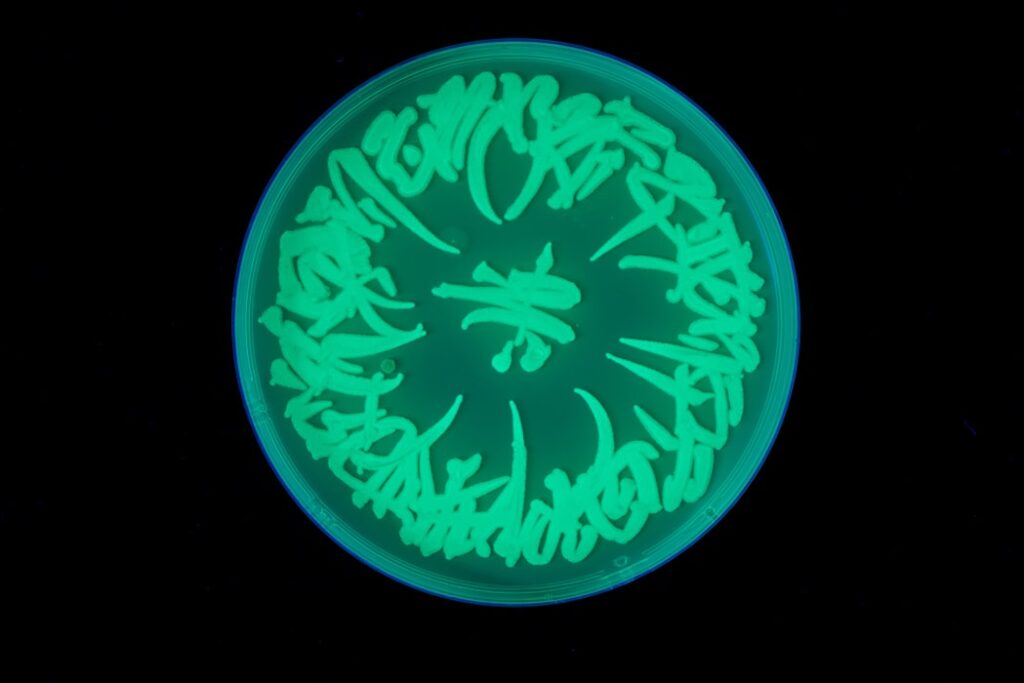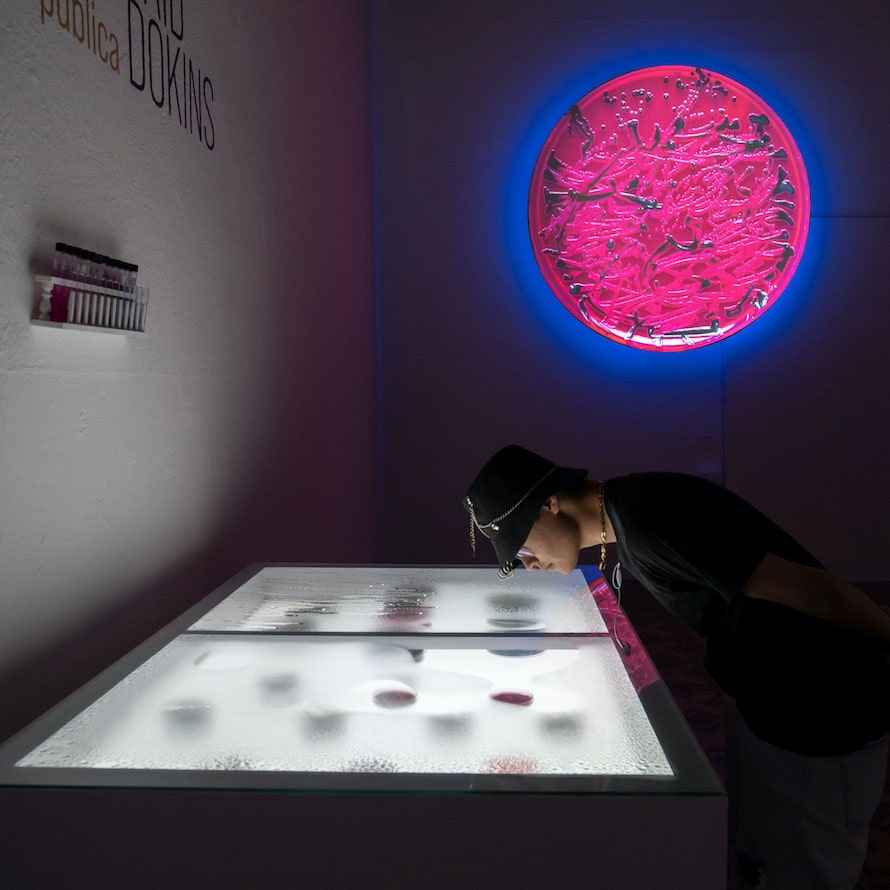The Interactive Municipal Museum of Puebla in Mexico (MUI) presents the artwork “Bio-Rescriptures” by artist Said Dokins as part of the exhibition “Atentar desde los códigos” (Attack of Codes), which will be on display throughout May at Calle Norte 4 No. 5 in the historic centre of Puebla.
Fig. above: Said Dokins, Bio rescrituras, Bioart, Calligraphy, Graffiti calligraffit (000) Photo Leonardo Luna
The exhibition Atentar desde los códigos, curated by Piedad Martínez and Juan Carlos Montes, proposes to explore the tensions and conflicts that arise from the discourses and appropriation of cultural heritage in relation to socio-cultural logics. In this exhibition, artists such as Rocío Cerón, Malitzin Cortéz, Ivan Abreu and Said Dokins present the results of their artistic residencies at the Tec de Monterrey campus in Puebla and Querétaro.
“Bio-Rescriptures” is the latest work by artist Said Dokins, which takes as its starting point the realisation that the human body is a permeable subject for advances in the study of the human microbiome. The project includes various experiments that document the imprints and traces created by the interaction between different microorganisms and individuals.
Through his work, Dokins aims to challenge traditional notions of the body as a closed and individualised entity. He explores the connection between the human body, the microbiome and the environment through a microperformative exercise that analyses and refers to the process of scientific knowledge production.

Current research on the microbiome confirms that microorganisms live in symbiosis with the human body and are in constant exchange of information through chemical signals that trigger reactions in various metabolic centres. These studies lead to a better understanding of the human body as an ecological unit, as a holobiont in constant feedback with its environment.
The project is presented as an audio-visual installation combining advanced photographic techniques such as focus stacking, timelapse, video mapping and biological processes through cell cultures that change and update throughout the exhibition.
The installation consists of three moments: Recording the growth of samples of microorganisms collected on daily routes by students of the Tec de Monterrey Campus Querétaro, calligraphic executions with pathogenic and non-pathogenic bacteria from the human body in culture media, and portraits generated by horizontal transfer of human genetic material into bacteria.

Corporal geographies and itineraries: Exploring microbial landscapes of human movement and bacterial patterns in public space.
The aim of this series is to document the microbiological patterns in the daily walks of 45 students from the Tecnológico de Monterrey. The participants placed their handprints on plates of nutrient-rich agar and potato dextrose agar enriched with rose bengal, which were then incubated to visualise the growth of microorganisms. The growth is displayed in the museum over several days until the medium dries out, creating a dynamic microbial footprint that depends on the geographical space of the individual.
Bioscripts, biostencils and bacterial patterns in culture media: the intersection of script and microbiology
Bio-Writings are based on calligraphic designs using a bacteriological ink produced by using pathogenic bacteria from the human body, such as Salmonella and E. coli, and non-pathogenic bacteria such as Saccharomyces in culture media. In the case of the Bio-Stencils, surgical steel stencils were used to restrict bacterial growth to the shadow areas of Said Dokins’ calligraphies. Both Bio-Writings and Bio-Stencils work with an abstract language that challenges conventional norms and structures, creating a new dialogue between the written and the living. Microorganisms find in the writing patterns a medium in which they can live and multiply, becoming a kind of bacteriological ink, the starting point for an exuberant, intertwined hybrid writing in which death and life still co-exist in a constant relationship.

Bio-fluorescent writings: The potential of bacteria in calligraphy through genetic engineering
Just as the human body is influenced by various microorganisms, humans have also developed sophisticated methods to influence their environment, including microorganisms. Biotechnology and genetic engineering have been used in medicine for insulin production, improving plant resistance to pests or gene therapy, etc.
In this phase of bio-rescriptures, horizontal gene transfer was used as a mechanism for information exchange between bacteria. This technique allows the direct modification of genetic material from one microorganism to another by altering membrane permeability to allow the passage of DNA fragments, which are incorporated as small circular DNA molecules called plasmids. For this experiment, a strain of Escherichia coli was used in which the gene for green fluorescent protein (GFP) was inserted. This genetic modification enables the bacteria to emit light when exposed to ultraviolet light, making them biofluorescent.
Colonies of the biofluorescent bacteria were cultured on selective media and used as bioink for calligraphic exercises on Petri dishes containing LB nutrient medium in the presence of arabinose. After the incubation phase, the petri dishes were irradiated with ultraviolet light to make the calligraphic strokes visible.
Said Dokins was not alone in this project. In the area of the laboratory, microbiology and genetic engineering, he received valuable support from respected researchers and professors at the Tec de Monterrey Campus Querétaro. Dr. Aurea Ramírez, a doctor of science who specialises in the food industry and has a profound knowledge of nutrigenomics. Dr Carmen González, an experienced pharmaceutical chemist specialising in molecular biology, who uses her expertise to unlock the secrets of life at the molecular level. And finally, Dr Paola Angulo, a pioneering scientist focusing on the fascinating field of plant biotechnology and genetic engineering.
The visionary artist Roberto Palma brought mapping to life, using his artistic skills to transport us to other dimensions and captivate our senses. Finally, the talent of Daniel Arp, a sound producer who created a wet-biological soundscape that evokes emotions and enriches Said Dokins’ narrative, ensures that the listening experience is perfect.
The exhibition runs until 29 May at the Urban Interactive Museum (MUI) at 5 North Street, Historic Center, Puebla.
WHERE?
Calle 4 Nte 5, Centro
72000 Puebla
Pue., Mexico
WHEN?
until Monday, 29. May 2023






